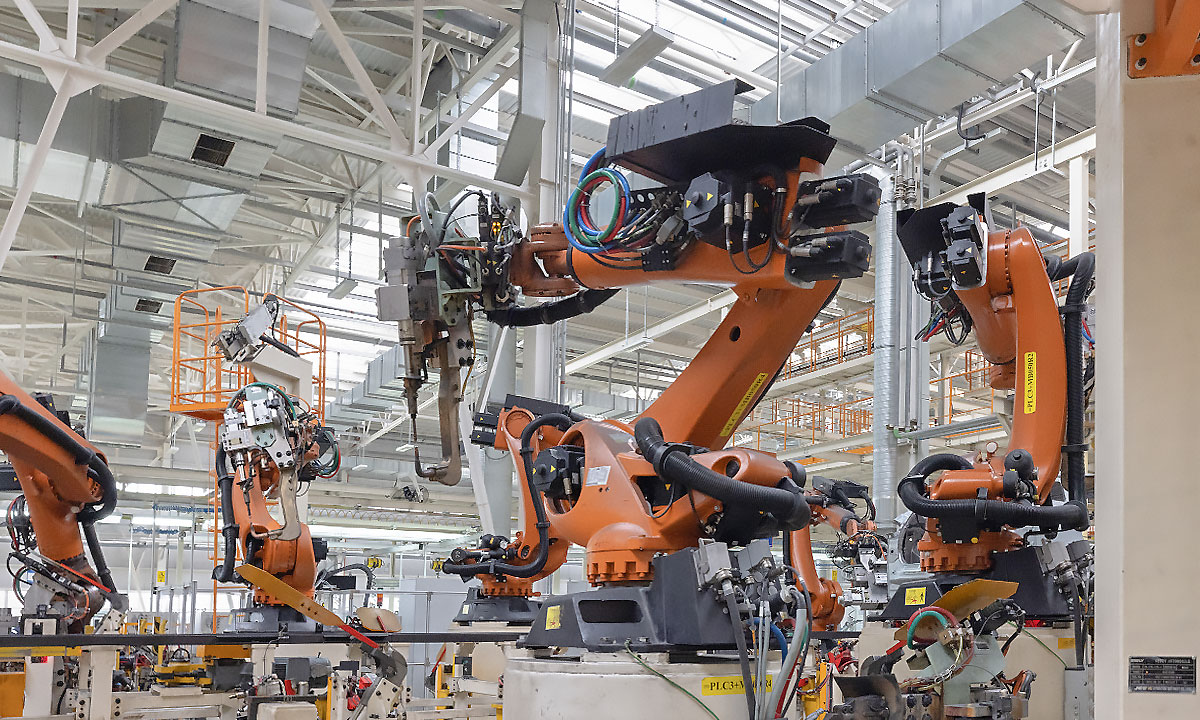Welcome to our exploration of the transformative impact of industry robots on manufacturing efficiency. In today's rapidly evolving technological landscape, industrial robots have become indispensable assets in enhancing productivity and revolutionizing traditional manufacturing processes. From articulated robots to autonomous systems, these advanced machines are reshaping industries across the globe.
Join us as we delve into the types, features, benefits, challenges, market structure, and future trends surrounding industry robots. Let's embark on a journey into the world of automation and innovation that is propelling manufacturing into a new era of efficiency and excellence.
Exploring the Impact of Industry Robots on Manufacturing Efficiency
Industry robots revolutionize manufacturing, boosting efficiency through automation and precision. These advanced machines streamline processes, enhance productivity, and ensure consistent quality across various sectors.
Types and Features of Industrial Robots
Industrial robots come in various types, including articulated, autonomous, Cartesian coordinate, cylindrical coordinate, spherical coordinate, SCARA, Delta robots, serial manipulators, and parallel architecture. Each type offers unique features and applications in manufacturing.
Articulated robots
Articulated robots are versatile industrial robots with multiple joints resembling a human arm. They excel in complex tasks requiring flexibility and precision, making them ideal for manufacturing processes like welding and assembly.
Autonomous robots
Autonomous robots operate independently, making decisions based on sensors and algorithms. They can navigate their environment without human intervention, increasing efficiency in manufacturing processes significantly.
Cartesian coordinate robots
Cartesian coordinate robots operate on a three-axis system, moving linearly along the X, Y, and Z axes. They excel in precise tasks like pick-and-place operations due to their accuracy and repeatability.
Cylindrical coordinate robots
Cylindrical coordinate robots operate with rotary joints at the base and a prismatic joint for vertical movement, making them ideal for tasks requiring extended reach and precision in cylindrical workspaces.
Spherical coordinate robots
Spherical coordinate robots have a unique design with a spherical work envelope. They are suitable for tasks that require flexibility in all directions, such as welding and painting applications.
SCARA robots
SCARA robots, Selective Compliance Assembly Robot Arm, are known for their fast and precise movements in horizontal planes. They excel in assembly tasks requiring high speed and accuracy.
Delta robots
Delta robots are parallel robots known for their high speed and precision. Consisting of three arms connected to universal joints at the base, they excel in tasks requiring fast and accurate movements in industries like electronics assembly.
Serial manipulators
Serial manipulators are industrial robots with a series of interconnected joints, allowing for precise and sequential movement. They are commonly used in applications requiring intricate and delicate tasks in manufacturing processes.
Parallel architecture
Parallel architecture in industrial robots involves multiple joints connected parallelly, allowing for increased speed and flexibility in operations. This design enhances productivity by enabling robots to perform complex tasks efficiently.
How Industrial Robots Improve Manufacturing Efficiency
Industrial robots enhance manufacturing efficiency through automation, reducing human error, increasing production speed, and ensuring consistent quality. These machines streamline processes and optimize workflow in various industries.
Industrial Robots Main Components
Industrial robots consist of key components like a controller, manipulator arm, end effector, and sensors. The controller manages robot movements, while the manipulator arm executes tasks with precision and efficiency.
Benefits of Industrial Robots
Industrial robots offer benefits such as increased productivity, improved quality control, enhanced workplace safety, reduced operational costs, and the ability to work in hazardous environments.
Applications of Industrial Robots
Industrial robots are widely used in manufacturing for tasks like welding, painting, and quality inspection. They streamline production processes and enhance efficiency in various industries worldwide.
Challenges Faced with Industrial Robots
Implementing industry robots comes with challenges like high initial costs, complex programming requirements, and the need for skilled technicians. Maintenance and troubleshooting can also be demanding tasks in industrial robot operations.
Market Structure and Leading Industrial Robot Companies
The market structure of industrial robots is diverse, with leading companies like Fanuc, ABB, and Yaskawa dominating the industry. These companies excel in innovation, reliability, and customer satisfaction.
What Makes An Industry-Leading Industrial Robot Brand?
When considering what makes an industry-leading industrial robot brand, factors such as technological innovation, reliability, precision, versatility, and customer support play a crucial role in setting apart the best brands in the market.
The Biggest Industrial Robot Companies
When it comes to the biggest industrial robot companies, names like Fanuc, ABB, Yaskawa Electric, and KUKA come to mind. These industry leaders are known for their innovative robotics solutions and cutting-edge technology.
Popular Industrial Robotics Companies
When it comes to popular industrial robotics companies, names like Fanuc, ABB, Yaskawa Electric Corporation, and KUKA AG often rise to the top. These industry leaders are known for their cutting-edge technology and innovative solutions in the field of industrial automation.
Choosing the Right Industrial Robot Brand
When selecting an industrial robot brand, consider factors like the specific application needs, reliability of the manufacturer, customer support services offered, integration capabilities with existing systems, and overall cost-effectiveness.
Impact of Industrial Robots on Different Sectors
Industrial robots revolutionize various sectors like manufacturing and assembly, material handling, welding, painting, quality inspection. Their precision enhances productivity and cost efficiency while ensuring safety standards are met.
Manufacturing and Assembly
Manufacturing and assembly processes are revolutionized by industry robots. Automation streamlines production lines, increasing efficiency and precision in tasks like assembling components or handling materials.
Material Handling
Material handling is a crucial aspect of manufacturing processes. Industrial robots streamline tasks such as picking, packing, and palletizing, leading to increased efficiency and reduced manual labor.
Welding
Welding is a critical application for industrial robots. They offer precision, speed, and consistency in welding operations, leading to higher quality welds and increased efficiency in manufacturing processes.
Painting and Coating
Painting and coating with industrial robots ensure consistent coverage, reducing human error. Robots can apply coatings in a controlled manner, improving quality and efficiency in the manufacturing process.
Quality Inspection
Quality inspection in industrial robotics ensures precision and consistency in product manufacturing. Robots equipped with advanced sensors and cameras meticulously inspect products, enhancing overall quality control processes within manufacturing facilities.
Precision and Repeatability
Precision and repeatability are crucial aspects of industrial robots, ensuring consistent performance in tasks such as welding, material handling, and quality inspection. These features contribute to enhanced efficiency and productivity in manufacturing processes.
Enhancing Productivity through Industrial Robots
Enhancing productivity through industrial robots is crucial for streamlining manufacturing processes. With increased precision, repeatability, and cost-efficiency, these robots improve output quality and safety measures in various industries.
Increased Productivity Factors
Increased productivity factors in the industry include faster cycle times, reduced downtime, improved accuracy, and enhanced output capacity. These elements play a crucial role in optimizing manufacturing processes and maximizing efficiency with industrial robots.
Precision and Repeatability
Precision and repeatability are crucial characteristics of industrial robots. These robots can consistently perform tasks with exactness, ensuring high-quality output in manufacturing processes. Their accuracy contributes to improved efficiency and productivity levels within various industries.
Cost Efficiency
Cost efficiency is a significant benefit of industry robots. By automating tasks and increasing productivity, companies can save on labor costs in the long run. This leads to improved profitability and competitiveness in the market.
Safety Enhancements
Safety enhancements in the use of industry robots are crucial for preventing accidents and ensuring a secure working environment. Advanced sensors, emergency stop features, and collaborative robots contribute to increased safety standards.
The Future of Industrial Robotics
With continuous technological advancements, industrial robotics is poised to integrate artificial intelligence and witness emerging trends in automation, enhancing efficiency across various sectors in the future.
Technological Advancements
The field of industrial robotics is rapidly evolving with technological advancements. Innovations such as AI integration and emerging trends are shaping the future of industry robots, revolutionizing manufacturing processes.
Integration of Artificial Intelligence
As technology progresses, the integration of artificial intelligence in industrial robotics is revolutionizing manufacturing processes. AI algorithms enhance robot decision-making, leading to more efficient and adaptable automation systems.
Emerging Trends in Industrial Robotics
As the industrial robotics industry continues to evolve, emerging trends are shaping the future landscape of manufacturing. One of the key emerging trends in industrial robotics is the integration of collaborative robots, also known as cobots. These robots work alongside human workers to enhance productivity and efficiency while ensuring safety in shared workspaces.
Another significant trend is the implementation of Internet of Things (IoT) technology in industrial robots, enabling them to communicate with each other and with other smart devices on the factory floor. This connectivity allows for real-time data analysis and decision-making, optimizing production processes and reducing downtime.
Moreover, advancements in machine learning and artificial intelligence are revolutionizing industrial robotics by enabling robots to learn from experience, adapt to changing environments, and perform complex tasks with higher precision and efficiency.
Furthermore, there is a growing focus on sustainability within the industrial robotics sector, with manufacturers developing eco-friendly robots that consume less energy and produce fewer emissions during operation.
These emerging trends in industrial robotics signal a transformative shift towards smarter, more efficient, and sustainable manufacturing practices. By embracing these developments, companies can stay competitive in an increasingly automated world while driving innovation and growth across industries.

























